You’re just trying to get Arise out of me
The Tales series sits in a weird position among the pantheon of long-running RPG series. It’s not completely unknown or unheard of, but its popularity doesn’t reach the heights of other contemporaries, especially in the West. Tales of Arise is a big swing at changing that, trying to draw new eyes to the series. But what’s really impressed me is how Tales of Arise has kept its core tenets vibrant in the process.
Tales of Arise is a standalone story, like many of the other Tales games, about the twin worlds of Dahna and Rena. Following an invasion of the former by the latter, Rena now rules over Dahna, enslaving its citizens to perform manual labor as part of an elaborate Crown Contest, where five Renan lords compete to become the next ruler.
The protagonists, Alphen and Shionne, both want to bring an end to this contest by overthrowing the ruling lord of each of Dahna’s five realms. Alphen is a Dahnan slave who can’t feel pain and was left without memories or even a name (at first) in a labor camp; Shionne is a Renan on the run who wants to take out the lords, and also has mysterious “thorns” that hurt anyone who tries to touch her. The pair get tangled up together by chance, and with the help of resistance leader Zephyr and a Blazing Sword pulled from the heart of a stolen master core that Shionne carries, they kick off a campaign of defeating lords and rectifying injustices around them.

Tales of Arise (PlayStation 5 [reviewed], PS4, Xbox Series X|S, Xbox One, PC)
Developer: Bandai Namco Studios Inc.
Publisher: Bandai Namco Entertainment
Released: Sept. 10, 2021
MSRP: $59.99
This setup works really well, because it highlights the tension and personal drama within the party early on. Alphen and Shionne are working together out of circumstance, but how they get along is a different story entirely, and seeing their relationship evolve as the tale gets spun works really, really well.
Just as powerful is the party that forms around them, as each carries their own burdens and past they have to work through. Law, the Dahnan citizen working for the secret police of Cyslodia, and Rinwell, a Dahnan who can wield astral artes despite those techniques supposedly only belonging to the Renans; Kisara, a Dahnan guard, and Dohalim, a Renan noble who has different views on Dahnans than other high-status Renans.
Relationships within the party have traditionally been a touchstone of Tales games, highlighted by the short skits that can be viewed while travelling around on the world map. And in Tales of Arise, the intra-party relationships are showcased in a lot of ways. One of my favorite things about Arise is how it folds the party’s growing camaraderie into all of its game mechanics. When you rest at a campsite, you’re greeted with the cast sitting around a campfire, cheerfully talking with each other; you cook meals, which can sometimes elicit short skits, and have Alphen talk to other characters, deepening their bonds. There are skits on the overworld, and also just ambient dialogue between characters, that can unfortunately get cut off by running into an enemy or moving into a new scene. Even while you’re fishing—a neat minigame that I only spent a little time with—characters will comment on Kisara’s big catches, or encourage her when one slips away.

Every character has their own relationship with each other, too. It’s easy to pair some characters, like Alphen and Shionne, off as obvious connections. But some of my favorite dialogues were the more humdrum conversations: Dohalim and Rinwell bonding over a shared love of history, or Alphen and Law encouraging each other. One of my favorite side quests just involves Kisara teaching Shionne to cook. That’s it. In that little side venture, you build up this party as a group that’s travelling together and developing real connections, that then come to bear in the story’s grander moments.
Because the main plot of Tales of Arise ends up being pretty massive in scale, I appreciated all the little moments. The main story works well too, though much better before things start to rapidly expand outwards; once the story reaches a certain scale, there’s an element of larger-than-life forces and truth-discovering that wore on me a bit. The quest to take down the lords has a surprising number of twists and good revelations that pulled at my heartstrings a bit, but as the curtain peeled back on what was really going on, I found myself caring more for the characters than the story at large.
The scale of production does help a lot with those aspects though, as Tales of Arise has clearly made strides in upgrading its presentation. It is honestly gorgeous at times, and each realm of Dahna has its own unique visual identity corresponding to its respective astral element that really makes them pop.

The art style definitely takes the world up a notch, and the action looks fantastic. I’m overall fine with skits moving into 3D, whereas they were previously 2D animated talking heads; I think my only gripe with the new look is that characters’ faces can seem sometimes a little too static. Some cutscenes really sell the emotions of a moment, but then in skits, the faces may get a little stiff compared to the dialogue happening on screen. The new look is an overall plus though, especially when it comes to combat.
And combat is really important when it comes to Tales games. Tales of Arise makes sweeping changes across the board, and that includes battles, which use a fairly straightforward combat system. If you’re unfamiliar with a Tales game, this might be the most welcoming to you yet, especially if you’ve played recent action RPGs like Scarlet Nexus or Final Fantasy VII Remake. While controlling one of the six characters like Alphen, which I did for the majority of the game, you can move freely about the circular arena, as well as dodge and jump. (This is a very dodge-oriented game, as Kisara is the only character that can traditionally block attacks in place of a dodge.) For characters like Alphen, dodging is especially encouraged, as a perfect dodge lets you get a follow-up attack that sets up for a combo very well.

Alongside your movement, there are basic attacks and artes. Artes are the Tales catch-all for special abilities, and generally, they’re either spells you have to channel and cast, or instant abilities you can add into your standard sequence of attacks. It didn’t take me long to get locked into my bread-and-butter combo of three attacks, into Demon Fang, into a launcher arte, three air attacks, and then re-ground with a landing arte. And as more artes get gradually incorporated over the course of the game, you can learn to add more and more until your combo string isn’t just long, but adaptable to different enemies or situations.
Though you start with three artes (one to a face button, with separate options for ground and air), you can eventually expand that out to a second set, which you swap between using a trigger. Even so, combos still feel fluid and fun to put together, with the alternative artes offering enough room to improvise on the fly and explore new ideas, eventually putting together long combos and perfect dodges through a hail of enemy attacks.
Tales games seem to love to trick you into learning how fighting games work, and playing as characters like Alphen or Law, that aim holds true. A big addition in this game is the Boost system, where party members have individual Boost Attacks that function kind of like assists in a Vs. style fighting game: hit the corresponding button, and a party member leaps in to attack the enemy. Every party member’s Boost Attack has its own properties too, so Shionne can ground a flying enemy with a barrage of bullets or Kisara can stop a charging enemy in its tracks with her shield.
All these attacks, when struck in a sequence for long enough, can build up a meter that will eventually let you use a Boost Strike, a devastating finisher move where two party members team up for a massive attack that usually wipes out regular foes and deals heavy damage to bosses. The Boost Strikes were a highlight of combat for me, and even after the 50th time seeing Dohalim and Rinwell perform Radiant Genesis, I was still appreciating how gorgeous it looked, while still being fast and not dropping the pace of combat. They feel like really good “coup de grâce” moments, punctuating long combos and tough fights.

Each character has a unique playstyle as well. Though I’m a stickler for playing the protagonist character on my first run of a Tales game, Rinwell might have finally won me over to the mage team. Not only can she store charges of her spells, letting her combine artes for even more devastating attacks, but her Boost Attack also lets her steal an enemy’s arte and seal off their ability to cast for a short period of time. It’s a really fun system that makes the magic in Tales feel more interactive and alive. Other characters, like Shionne with her rifle and magic bombs or Dohalim’s rod extension, all have their own fighting styles that make them feel very much their own.
Which brings us to the change I came to head with most often: the Cure Points. While artes usage is only limited by your artes gauge, which replenishes in battle, restorative artes also use up CP, a pool of points that persists between battles. Every time a healer like Shionne or Dohalim uses a skill to heal someone, it dips into the CP pool, and when it runs out, no more magical healing. There are consumable gels that let you restore your Cure Points, which become vital during long dungeon runs, because otherwise you have to camp or rest at an inn, or chance upon a glowing circle that restores all HP and CP (usually found just in front of a boss room).
The CP idea is novel, and it emphasizes both the use of campfires and the importance of not getting hit. Early on, it’s easy enough to skate through a dungeon with one full pool, and maybe an Orange Gel or two for safety. But as enemies get larger and higher in level, that CP becomes vital, and the gels are not cheap by any stretch of the imagination.
The battle camera can also get finicky towards the end of the game, as it starts to chuck larger and larger monsters at you to fight. I didn’t have too much trouble for most of the game handling regular mobs, and the boss fights usually had good focusing too, but when there are sometimes three or four massive scale foes on the field at once, things can get a bit hard to read as spells start flying and giant hammer-maces start swinging.

The combat is really satisfying overall, though. The intrinsic rhythm of Tales is still here, but with a more simplified layout and a focus on team attacks and counters. It really hits its stride against boss enemies, and in Tales of Arise, there are plenty to go around. There are a lot of optional bosses to fight, as part of the side quests, and they’ve got some really cool attacks, mechanics, and style. One of the most jaw-dropping fights in this game both requires a high level and is completely optional, and the first time I ran into it I was floored. It seems like there’s some good post-game content, plus New Game Plus, to keep players interested in the long term.
After spending roughly 54 hours with Tales of Arise to see it through to credits, I was reminded what this series is. It’s got a solid story, with some tedious lows and really great highs at times; it’s got combat that’s fast and involved, that challenges me and feels like the meeting point between traditional RPG and fighting game; and it has a stellar core cast, one that I’m happy to spend hours and hours with walking around the world.
Ultimately, Tales of Arise gets that right, while upgrading the overall production in the process. Whether this is the big Tales breakthrough or not is a matter that history will decide. This is a Tales game that hits the right spots for me, puts a lot of love into its cast and its action, and somehow manages to strike a balance between the old and the new. It’s not without a few shortcomings, but it’s also got a lot of improvements that at least shore those up a bit.
When I think back on Tales of Arise, the combat will definitely come to mind. The big boss battles that blew me away, and the wonderful feeling of free-forming a combo into a Mystic Arte and then closing the battle off with a Boost Strike. The story was ultimately good, and the world was gorgeous. But really, it’s going to be the campfire moments. It’s going to be how Alphen, Shionne, Rinwell, Law, Kisara, and Dohalim came together as a party, grew closer, fought and struggled together, and saw it all through to the end, one hastily thrown-together outdoor meal at a time. Tales of Arise nails that, and so it feels like a strong step forward for a series with a bright future ahead of it.
[This review is based on a retail build of the game provided by the publisher.]





